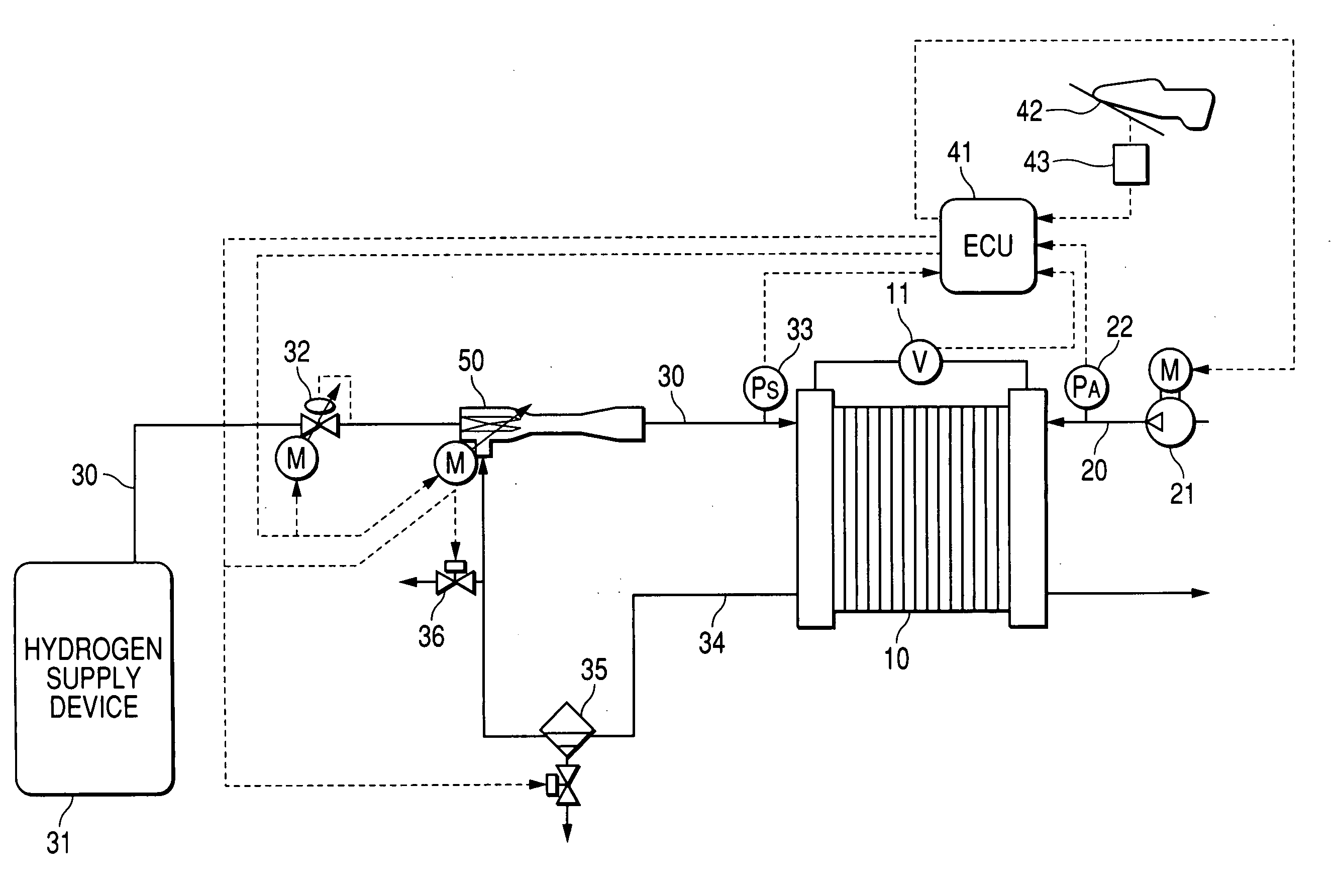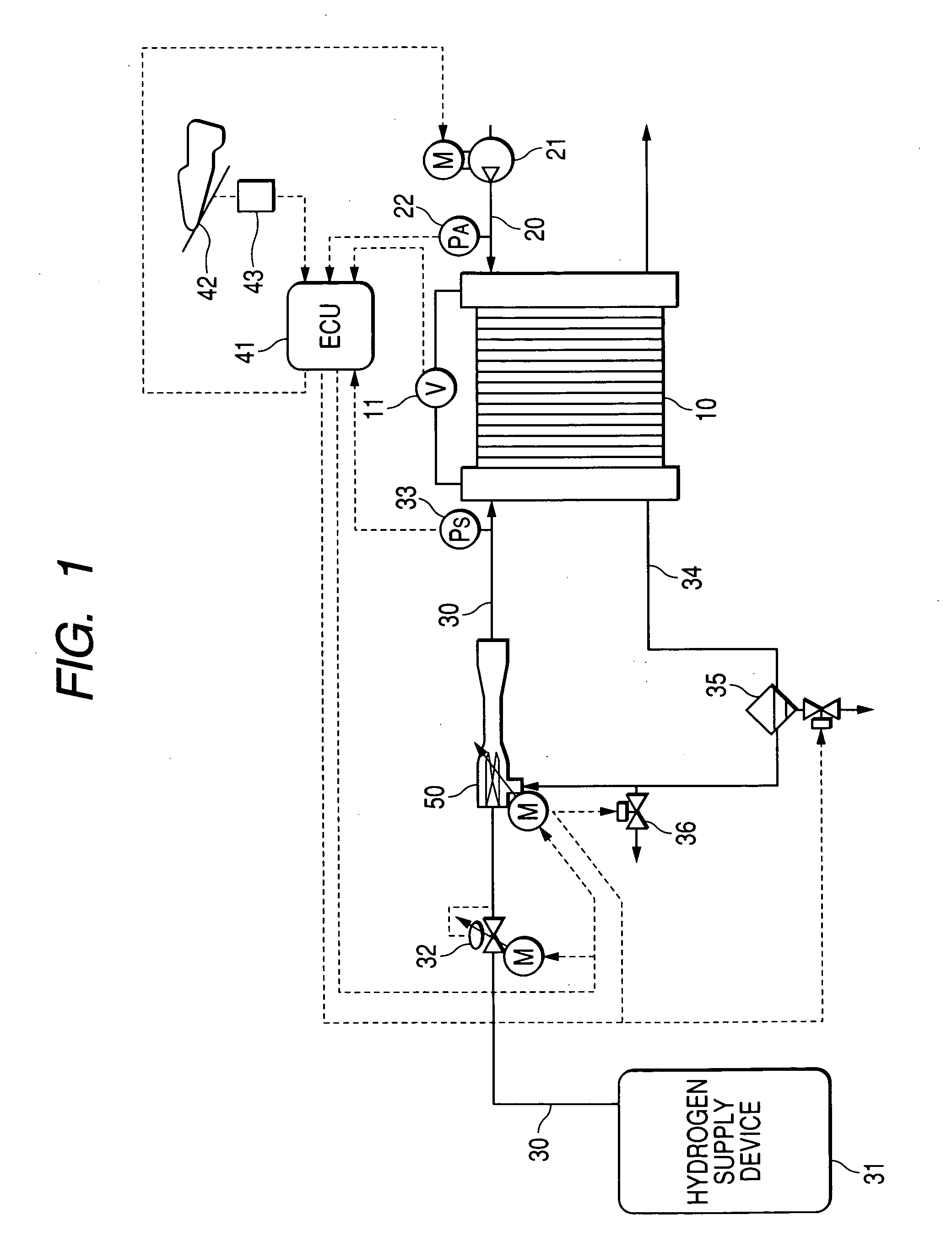Fuel supply system for fuel cell system designed to ensure stability in regulating flow rate of recirculated off-gas
a fuel supply system and off-gas technology, applied in the direction of fuel cells, cell components, solid electrolyte fuel cells, etc., can solve the problems of failure of flow regulator operation, inability to control difficulty in controlling the flow rate of off-gas to be recirculated to the fuel cell, etc., to achieve ease and increase the flow rate
- Summary
- Abstract
- Description
- Claims
- Application Information
AI Technical Summary
Benefits of technology
Problems solved by technology
Method used
Image
Examples
first embodiment
[0033] Referring to the drawings, wherein like reference numbers refer to like parts in several views, particularly to FIG. 1, there is shown a fuel cell system equipped with a fuel supply system according to the invention which is employed in an electric automobile driven by fuel cells. The fuel cell system consists essentially of a fuel cell stack 10, an air supply device 21, a fuel supply device 31, an ejector device 50, and a controller 41. The ejector device 50 may be implemented by an ejector vacuum pump and will be referred to as an ejector vacuum pump 50 below.
[0034] The fuel cell stack 10 works to convert the energy produced by electrochemical reaction of hydrogen (i.e., fuel) and oxygen (i.e., oxidizing agent) into electric power. The fuel cell stack 10 is made up of a plurality of solid polyelectrolyte fuel cells (PEFCs). Each cell is made up of a pair of electrodes (will also called an oxygen and a fuel electrode below) and an electrolyte film disposed between the electr...
second embodiment
[0064]FIG. 4 shows a fuel supply system according to the invention. The fuel supply system includes a humidity sensor 37 which measures the humidity H of the mixture of the hydrogen gas and the off-gas flowing through a portion of the hydrogen supply line 30 downstream of the ejector vacuum pump 50. The controller 41 works to control the recirculated off-gas flow rate Ge as a function of the humidity H, as measured by the humidity sensor 37, to bring the humidity H into agreement with a target humidity Hn required by the fuel cell stack 10 (i.e., the amount of moisture to be added to the fuel cell stack 10).
[0065] The required humidity Hn depends upon a power generating condition (e.g., the generated current) of the fuel cell stack 10. The controller 41 determines the required humidity Hn and controls the amount of the off-gas containing moisture to adjust the humidity H, as measured by the humidity sensor 37, to the required humidity Hn. Other arrangements and operations of the fue...
fourth embodiment
[0068]FIG. 6 shows a fuel supply system according to the invention which is different from the above embodiments in that a temperature sensor 38 is installed in the off-gas recirculating line 34 to measure the temperature T of the off-gas, and the controller 41 controls the recirculated off-gas flow rate Ge as a function of the temperature T to bring the humidity of the B e supplied to the fuel cell stack 10 into agreement with the required humidity Hn.
PUM
 Login to View More
Login to View More Abstract
Description
Claims
Application Information
 Login to View More
Login to View More - R&D
- Intellectual Property
- Life Sciences
- Materials
- Tech Scout
- Unparalleled Data Quality
- Higher Quality Content
- 60% Fewer Hallucinations
Browse by: Latest US Patents, China's latest patents, Technical Efficacy Thesaurus, Application Domain, Technology Topic, Popular Technical Reports.
© 2025 PatSnap. All rights reserved.Legal|Privacy policy|Modern Slavery Act Transparency Statement|Sitemap|About US| Contact US: help@patsnap.com



